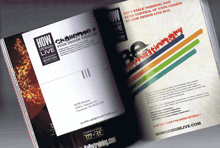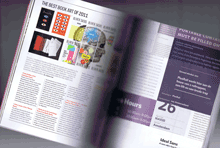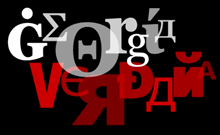The Print Regional Design Annual hove into sight the other day, joining the stack of recent graphic-design and typography magazines: Metropolis, Eye, Typo, and the new one, Codex. The Print annual was a particularly fat example, but then you’d expect it to be. What distinguishes all of these disparate magazines, however, besides interesting content, is their binding: every one of them has a flat spine.
What’s the point of this? To look at a set of issues on the shelf, after the fact? If a magazine contains enough pages, of course, you have no choice; it must be perfect-bound (the pages trimmed and glued into a spine), since saddle-stitching (folding the sheets and stapling in the middle) is only practical for a relatively thin publication. But it seems as though most magazines these days (not just graphic-design magazines) are bound so they have a flat spine, no matter how thin the issue itself may be. I even got an unsolicited men’s-clothing catalog last week, all of 68 pages, that was bound into a spine, for no apparent reason.
The problem with perfect-binding a magazine is that it won’t lie flat. Nor can you fold it open to read one page at a time, for convenience in a crowded space (or simply to keep the pages less floppy). The spine creates a gutter, which neither editorial designers nor designers of ads for those pages ever seem to take into consideration; on the inner edge, both images and text curve into the gutter and get lost. It’s possible to design with that in mind, but how often have you seen it done?
Print is a perfect example of the real advantage of a glued spine to the publisher of a graphic-design magazine: it makes it very easy to bind in inserts from paper companies who want to show off their wares to potential customers. This isn’t new; the very first issue of Print, in June 1940, included paper samples to accompany an article on the design of wallpaper, and subsequent issues had bound-in samples from printers and paper manufacturers. Today, Print and other popular design magazines like How are thick with this kind of insert. These stiff or thick or off-size pages may serve a function, as illustration or advertising, but they make it impossible for a reader to flip through the pages – one of the most common ways of reading or browsing any printed publication.
The roadblocks along the path through a magazine rarely come at logical stopping or starting points in the magazine’s content. Very few magazines these days maintain an “editorial well” that’s separate from the advertising, and converging trends in editorial and commercial design make it hard to tell the content from the ads. That’s hardly a new trend, but it’s reinforced by the random-seeming intrusions of stiff-papered inserts.
The current popularity of spines on magazines seems part of a dismissive approach that looks at the magazine (or a book, for that matter) as a physical object to be sold, without giving any thought to how that object will be used. There are exceptions – Eye, for instance, uses multiple paper stocks in each issue, but they have similar weight and flexibility; and the page design almost always takes the gutter into account, so despite being perfect-bound, Eye is pretty comfortable to open and read. So is Typo, although its binding is stiffer than Eye’s. But Typo is usually thin enough that it could dispense with the spine entirely, which would make it easier to hold and read.
Some magazines have content that demands immersive reading; others are almost entirely meant for casual browsing. Neither of these functions is well served by pages that are tightly bound into a hard spine.
[Images: two spreads from the Print Regional Design Annual 2011.]



